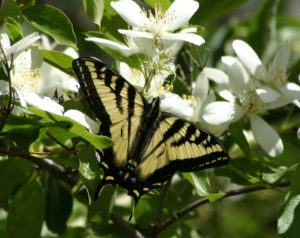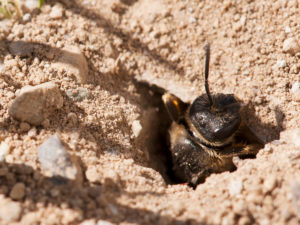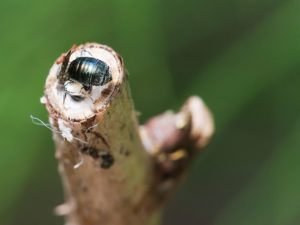Why Create the Guide?
In the Pacific Northwest, hummingbirds, bees, butterflies, moths, flies, wasps, and beetles are examples of native pollinators that feed on the sugary flower nectar and/or protein-rich pollen of flowering plants. Pollinators are in serious decline due to habitat loss and fragmentation, pollution, pesticides, non-native species, and climate change.
The Green Seattle Partnership has seen an uptick not only in native pollinator enthusiasm, but also on-the-ground projects to support their habitat. EarthCorps set out to gather Puget Sound-specific data, anecdotes, and lessons learned over the years to create a how-to practitioner guide. It serves as a set of best management practices (BMPs) for native pollinator habitat restoration in the Puget Sound region. It is geared towards planners, land managers, restoration practitioners, farmers, gardeners, orchardists, teachers, students, and homeowners.
This guide is based on the ‘set the table’ concept that by actively restoring the physical structures and plant communities of an ecosystem, species diversity, network resilience, and network function can follow.
Did you know?
Structural diversity of plants is a critical factor to forming rich, varied pollinator habitat. A variety of plant forms (e.g. branching trees, thicket-forming shrubs, creeping groundcovers, etc.) will support a variety of insect and animal species. Strive to establish multiple vertical layers (strata) of plant heights. Where appropriate, include both annual and perennial species, as well as both woody and herbaceous plants. Even non-flowering plants, like sword fern, can be helpful in a pollinator restoration because they are hardy evergreens that create structure. Flowers with a variety of different shapes (e.g. flat radials, cups, rounded domes, tubular trumpets, etc.) will appeal to an array of pollinators with differently shaped bodies.
Undisturbed and untidy sites provide the best shelter. In landscaping areas, it is beneficial to leave some designated areas in an un-manicured state by leaving branches and leaves on the ground, and minimizing mowing. In agricultural areas, no-till practices can dramatically limit soil disturbance.
Spots of bare, undisturbed ground allow ground-nesting bees to make a home. They need a few spots that are un-vegetated and un-mulched, even better if they are sunny and gently sloped. Well-draining soils that are sandy or loamy are preferred.
Most native bees are solitary- they nest individually or in small groups. Most solitary bees are ground nesters, e.g. digger bees, mining bees. Look for pencil sized holes surrounded by tiny mounds of dirt, typically found in areas of compressed soils.
Moths are nighttime pollinators and they need night-blooming plants. Artificial light at night disturbs their life cycle.
Hummingbirds have no sense of smell. They pollinate tubular flowers with their long bill, and are mostly drawn to reds and hot pinks.
“Mud-puddling” butterflies congregate in areas of wet or moist soil in search of salt and other minerals.
Red, orange blooms more often draw hummingbirds and butterflies. Bumble bees can’t see red.
Blue, purple blooms are a big draw for bees.
A Note on Restoration
Ecological restoration is evolving on many fronts – in scientific studies, boardrooms, classrooms, and of course, in the field. Educational guides like this one aim to digest the diverse mix of science, practice, anecdotes, failures, and lessons learned into a useful resource. More and more, these resources tell us that in most cases, we cannot recover nature to a historical paradise that once was. Instead, what we can ‘restore’ is connectivity, resiliency, and natural processes, within a context that is always changing.
Burke-Gilman Case Study
The natural connectivity of the Burke Gilman trail (BGT) is perfect for travelling pollinators. GSP is hard at work converting the popular bicycle and pedestrian route into a native pollinator corridor. In 2017, the section between Gas Works Park and the I-5 overpass underwent some massive changes. Two volunteer events, 700 crew hours, and far too much plant geeking out by the EarthCorps Science team later, and pollinator habitat is on its way! Non-native grasses and Himalayan blackberry were removed and the ground was sheet-mulched to suppress the grass and enrich the soil. 4000 shrubs and forbs were installed and maintenance is ongoing. Mulching will be phased out to allow for ground-nesting bees to find refuge in patches of bare soil. Native species diversity improved by over 400% and a wider array of pollinators are starting to move back into the site.
The primary challenge at this stage is maintenance of invasive species re-growth. We are still learning which herbaceous plants can survive in these largely inhospitable (poor soil, high invasive plant pressure, etc.) sites and which ones need watering to survive the first few years.
–Matthew Schwartz, Ecologist & Field Operations Manager at EarthCorps





